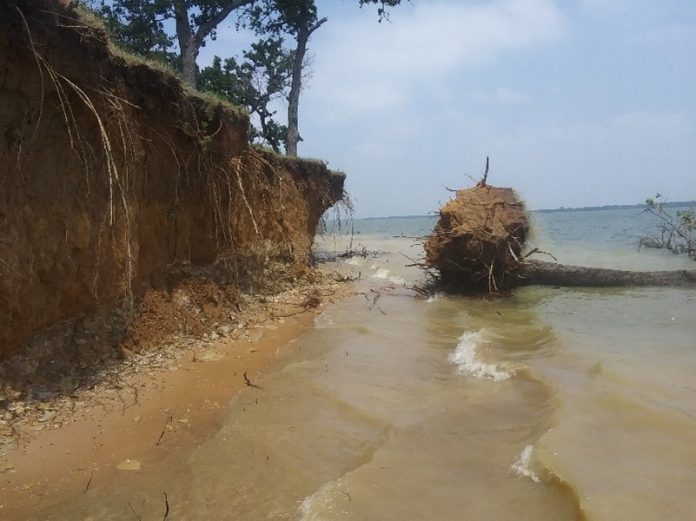By Paul F. Hudak, Department of Geography and the Environment, University of North Texas.
Multi-purpose water supply and flood control reservoirs sustain communities worldwide. Texas, U.S., has more than 150 freshwater lakes (TPWD, 2024) — all but one a built reservoir. Numerous lakes sustain the Dallas-Fort Worth metroplex in north-central Texas by providing flood control, recreation, and most of the water consumed in the region.
Critical infrastructure, these lakes lose large amounts of water by evaporation and trap sediment that reduces storage capacity, degrades water quality, and compromises aquatic habitat. Tributaries and backshore are major sources of sediment to lakes in general. A recent study examined shoreline erosion at Lewisville Lake in north-central Texas, U.S.

Study Area
Lewisville Lake is owned and operated by the U.S. Army Corps of Engineers, Fort Worth District (TWDB, 2007). An earthen dam impounds the lake, which controls flooding, provides water to local cities and water authorities, and supports recreation such as fishing and boating. Treated wastewater from nearby communities also enters Lewisville Lake. The lake fluctuates widely around a conservation pool elevation of 522.0 feet (159.1 m) above mean sea level due to seasonal and annual variability in rainfall and runoff (NWS, 2024). The lake has a capacity of 598,902 acre-feet (738,734,000 m3) and covers 27,175 acres (10,997 ha) at conservation pool but loses approximately 540 acre-feet (670 m3) of capacity per year from sedimentation (TWDB, 2007).
Wind-driven waves erode backshore areas on Lewisville Lake. Hourly, winds in the study area exceed 2 miles per hour (mph) (3 km/h) 90.3% of the time and average 9.2 mph (14.8 km/h) (IEM, 2024). Winds are prevalent from the south-southeast (SSE), with a directional mode of 20 degrees east of south (S20E). This directional mode approximately aligns with the main branch of the lake, thereby increasing wave fetch and energy from the SSE (Figure 1). Approximately 34.6% of the time, winds arrive from the directional range S45E to S4W. Moreover, most of the 20+ mph (32+ km/h) winds producing damaging waves, which happen 3.8% of the time, come from S45E to S4W.
In addition to wind patterns, composition and texture of earth material largely determine vulnerability to backshore erosion. Two Upper Cretaceous bedrock formations, striking north-northeast and dipping east-southeast, and unconsolidated Quaternary alluvium, form the backshore along Lewisville Lake. Occupying approximately the west-northwest half of the lake, the Woodbine Formation consists of loose to moderately-well cemented ferruginous argillaceous sands and laminated sandy clays deposited in a deltaic setting (Hill, 1901). Over the remainder of the lake, the Eagle Ford Formation consists of fissile argillaceous marine shale (Hill, 1901). Discontinuous (patches) of Quaternary alluvium including sand, gravel, and clay overlies bedrock along the backshore.
Methods
Due to wind patterns outlined above, segments of shoreline in Lewisville Lake that face SSE are especially prone to wave impact. Three SSE-facing segments of shoreline were studied, one each in alluvium, sandstone, and shale. Periodically, as lake level approaches and exceeds conservation pool elevation, waves attack parent material and overlying soil at the backshore along the lake. Soil is well developed on the terrace and shale study sites, but thin to absent on the sandstone site. Vegetation is present at each of the three sites. Native vegetation including trees and shrubs occupies the sandstone site, whereas landscaped properties dominated by turf grass are present at the terrace and shale sites.
Two 300-m segments of shoreline, from February 2001 and 2024, were digitized from Google Earth (Google Corporation, Mountain View, California) satellite imagery at each study site. These dates were the earliest and most recent with high-quality imagery for the study area in Google Earth.
Results
Digitized shorelines were irregular, a consequence of differential erosion resulting from variable composition and texture of earth material. The terrace and shale shorelines were somewhat smoother than the sandstone shoreline, reflecting varying amounts of cementation affecting resistance to erosion in the sandstone.
Along representative S20E transects, from February 2001 to 2024, 22.83 m of backshore retreat was measured at the terrace site, 16.58 m at the sandstone site, and 52.00 m at the shale site. During field visits when waves impacted the backshore, water was visibly turbid at the shale and terrace sites from suspected sediment (silt and clay) eroded from the backshore. In addition to sediment, uprooted vegetation had moved from the backshore into the reservoir (Figure 2). Dislodged vegetation is a concern, because it no longer acts as a carbon sink but instead releases carbon to the atmosphere, can damage piping and other lake infrastructure, and is a significant boating hazard.
From the data above, approximate rates of shoreline retreat were 0.99 meters per year for terrace deposits, 0.72 meters per year for sandstone, and 2.26 meters per year for shale. Thus, earth material had significant impact on erosion rates, with much higher rates observed in shale, which tends to be relatively weak and prone to erosion. Waves dislodge and wash away fine sediment prevalent in shale and terrace deposits. Shale also undergoes dissolution of calcite cement and weakening from wetting (swelling) and drying (shrinking) cycles enhanced by wave activity. Numerous shale fragments were observed at Site 3.
In addition to evaluating erosion rates at specific locations, the approach outlined above can be used to identify other segments of lakeshore that warrant further study and possible mitigative measures. For example, riprap is used to slow erosion at several locations on Lewisville Lake. Rock-filled wire baskets (gabions) are commonly used to stabilize eroding lake and riverbanks. Flexible mesh rolls filled with rock have also been used to stabilize reservoir banks while providing habitat for aquatic invertebrates (WIJ, 2024). Less sturdy, though potentially useful alternatives include geotextiles, coir logs, and grassy vegetation.
Offshore breakwaters (typically, large rocks in a linear ridge) have slowed erosion and improved aquatic habits in littoral zones of some reservoirs (Severson et al., 2009). However, breakwaters are less practical for Lewisville Lake due to large lake level fluctuations and boating concerns; they would be fully underwater or on dry ground for extended periods of time. Land use planning that preserves binding vegetation, prevents intensive development, and slows or diverts runoff away from the backshore can also slow erosion at many locations.
Conclusion
Satellite imagery is useful for evaluating lakeshore erosion, a process of concern to lake managers, property owners, and others using lakes for recreation. Earth material and wind orientation are key factors affecting vulnerability of lake shores to wave erosion. Backshore areas made of relatively weak earth material that face prevailing wind modes, and impacted by waves with long fetch, are especially vulnerable to wave erosion.
Erosion rates on vulnerable segments of shoreline in Lewisville Lake ranged from approximately 0.72 meters per year for sandstone to 2.26 meters per year for shale. Wave erosion creates problems by increasing turbidity, taking up storage, and supplying vegetation to reservoirs, in addition to losing backshore and associated habitat. Identifying and evaluating shorelines prone to erosion can help prioritize mitigative measures to slow this process while enhancing lake function.
References
Hill, R.T. 1901. Geography and Geology of the Black and Grand Prairies, Texas. U.S. Geological Survey Annual Report, 21,1-666. U.S. Geological Survey, Reston, Virginia.
IEM. 2024. Iowa Environmental Mesonet. Available from: https://mesonet.agron.iastate.edu/.
NWS (National Weather Service). 2024. The Climate of Dallas/Fort Worth. Available from: https://www.weather.gov/fwd/dfw_narrative#:~:text=The%20climate%20of%20Dallas%2FFort%20Worth%20is%20humid%20subtropical%20with,to%20more%20than%2050%20inches.
Severson, J.P., Nawrot, J.R., Eichholz, M.W. 2009. Shoreline stabilization using riprap breakwaters on a Midwestern reservoir. Lake and Reservoir Management, 25(2), 208-216.
TPWD (Texas Parks and Wildlife). 2024. Texas Freshwater Lakes. Available from:
TWDB. 2007. Volumetric and Sedimentation Survey of Lewisville Lake. Texas Water Development Board, Austin, Texas.
WIJ (Water Industry Journal). 2024. Reservoir wall rebuilt with nature-friendly rock bags. Water Industry Journal, 30, 13.




